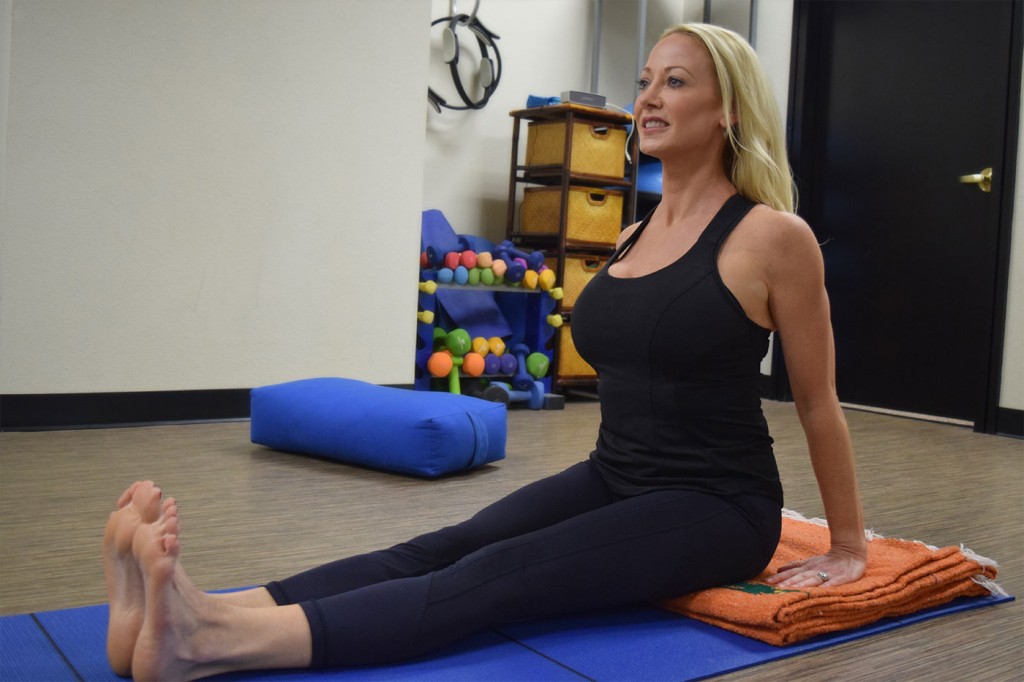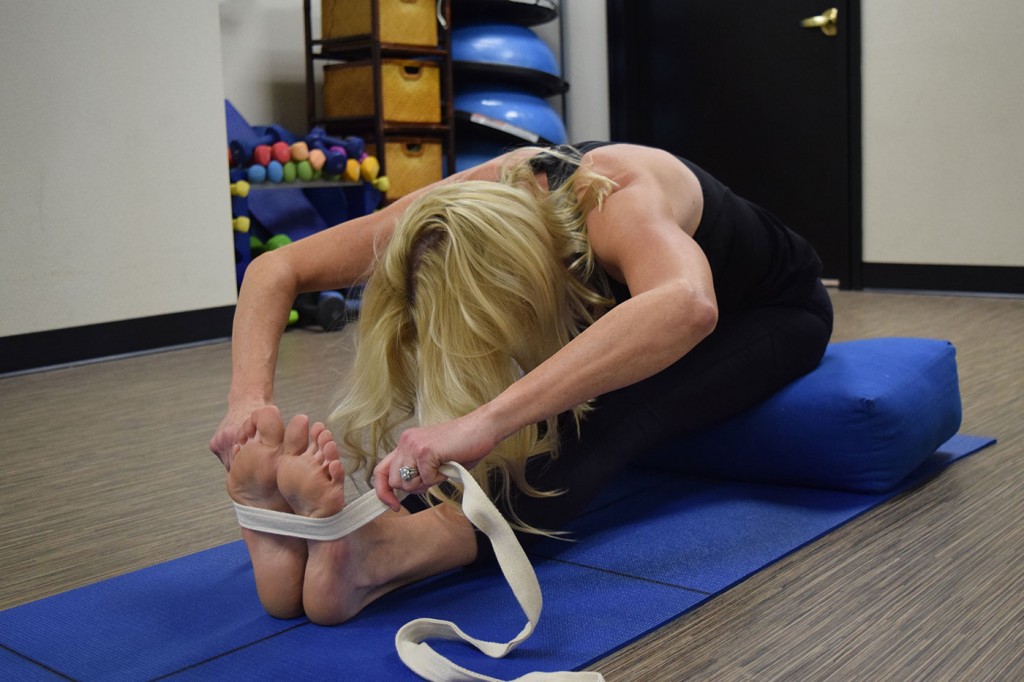Free your pelvis and relieve your back pain with these two Yoga hamstring stretches: Dandasana and Paschimottanasana. You’ll begin with Dandasana, also known as “Staff Pose.” Dandasana is an easy pose where you are sitting upright with a forward bend posture that will help improve your sitting posture and core strength. Ready to take it up a notch? Paschimottanasana will take you to the next level of flexibility by lengthening the hamstrings as you lean forward to hold the feet.
Why you need to be doing Dandasana and Paschimottanasana
Tight hamstrings will pull down on your sit bones, which causes your pelvis to tilt backwards or posteriorly. This posterior pelvic tilt flattens the low, lumbar curve of the spine, which results in a slouched posture when sitting and a lack of a lumbar curve when standing—both of which can put stress on the spine and create back pain with everyday activities. If the tightness is severe and persists, then the anterior compression of the vertebrae on intervertebral discs pushes the discs back into the spinal cord; this increases your risk of developing a herniated or “slipped” disc. Ouch! Don’t let this happen to you… start using Dandasana and Paschimottanasana daily!
Benefits of Dandasana
|
Benefits of Paschimottanasana
|
How to do Dandasana/Paschimottanasana
Begin in Dandasana
-
- Sit on the floor with your legs stretched out. Move the flesh of the buttocks out to the side to feel the sit bones pressing down into the floor or lift. Keep the knees and feet together with the ankles flexed and toes pointing up.
- Press your palms on the floor beside your hips with the fingers facing forward. Lift the chest up. Tighten the quadriceps by pressing the inner thighs down firmly. Move the navel toward the spine and engage the abdominal muscles. Lift from the sides of the waist up along the side ribs. Lift the breastbone, as the collarbones spread and the shoulders move back. Softly gaze straight ahead, ascending through the crown of the head. There should be a natural lumbar curve in the spine in this pose.
Move into Paschimottanasana
- Sitting in Dandasana, maintain the lift of the spine and the press of the legs as you inhale and lift your arms overhead with palms facing each other. Exhale – Release the shoulder blades down the back, creating space between the shoulders and ears.
- Inhale – Lift the spine. Exhale – Move the naval towards the spine and tilt the pelvis forward as you reach for the toes with a concave spine and lifted chest. Maintain the strong press of the thighs and heels down. Do not let the heels lift off the floor. Do not raise the buttock sit bones off the floor.
- Depending on your flexibility, hold either the calves, big toes, soles of the feet or hold hands past the soles of the feet.
- When you have reached as far as you can towards your toes with a straight spine, then allow the head to release down to place it on your shins. Lift the elbow wide. Hold the posture for 1 minute.
IMPORTANT! Respect your body’s limits and do not move into pain. Put ease into the pose by moving slowly, mindfully and maintaining softness in your face. Nobody cares if you can reach your toes.
Dandasana/Paschimottanasana Modifications
- You may need to sit up on a blanket or bolster lift, if you are unable to sit with an uplifted spine and a natural lumbar curve. Sit on the edge of the blanket to stabilize and protect the hamstring attachment.

- Hold and pull back on the end of a strap that is placed around the feet to help lift the chest and keep a natural lumbar curve.

- To rest the head down in Paschimottanasana, place a bolster or folded blankets on your thighs if you lack hamstring flexibility.

Injured Hamstrings?
Hamstrings are most commonly injured at the attachment on the sit bones. It is important stabilize this attachment by sitting the edge of blanket lift and to not let the pelvis tilt forward from its neutral position. The sit bone should remain pointing down and the back not to arch to prevent further injury. Stop when you feel strain or any pain on the attachment at the buttock. Do not attempt Paschimottanasana if you feel any discomfort in Dandasana.
Nerve Pain?
Many people feel nerve pain when bending forward or lifting their legs. This is often due to a herniated disc. It is very important that the natural lumbar curve is maintained by keeping the pelvis in a neutral or slightly forward tilted position. This can be done with the help of the blanket lifts and the strap. If you feel nerve pain, back off and ensure that you maintain an anteriorly or forward pelvic tilt to prevent rounding in the lumbar spine.
Namaste.
Liz Montagna MPT, RYT
Liz teaches in the Iyengar yoga tradition.

Liz Montagna is the founder of Yoga Physical Therapy in Orange County. For the past 16 years, she has been integrating her extensive knowledge and experience in the field of physical therapy with the therapeutic benefits of Iyengar Yoga to offer a more comprehensive and holistic approach to total patient care. As our resident Yoga instructor, Liz uses various forms of biofeedback and facilitation techniques to assist her students in gaining greater spacial awareness, motor control and muscular balance.
Click here to learn more about Liz and the other ABC Instructors.
